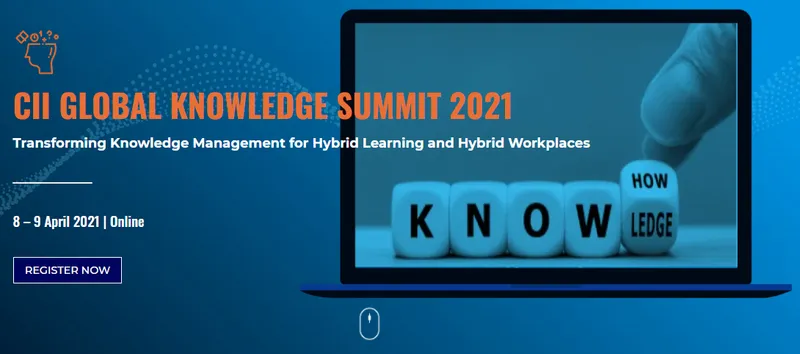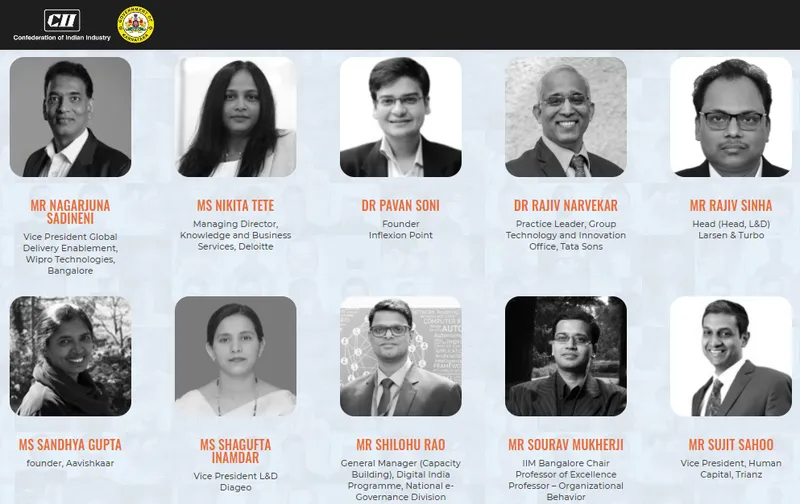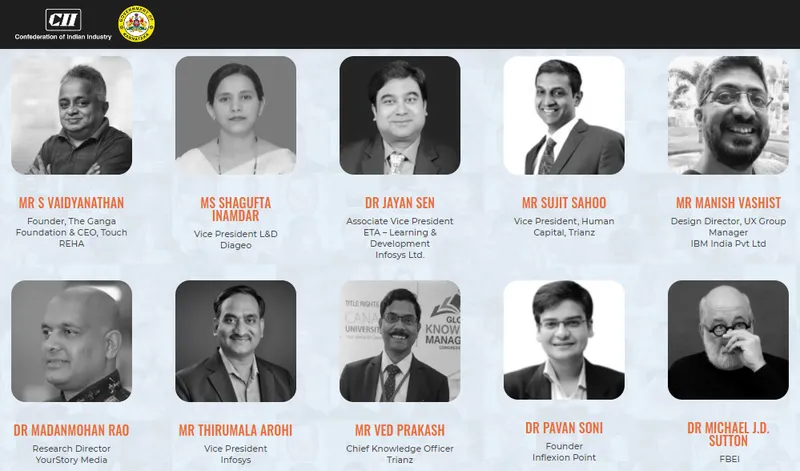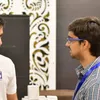The acceleration of remote learning: CII Global Summit highlights future of knowledge work
In this preview article on CII’s upcoming annual summit, we share insights on the continued rise of remote learning, impacts, and trends.
CII’s annual Global Knowledge Summit is being held entirely online on April 8-9 next week. The theme of the 16th summit is Transforming Knowledge Management for Hybrid Learning and Hybrid Workplaces.
As media partner for the Knowledge Summits, see YourStory’s coverage of the editions from 2021, 2020 and 2019, and sessions takeaways from the Bangalore K-Community meetups.
See also our profiles of MIKE (Most Innovative Knowledge Enterprise) award winners EY, Tata Steel, Cognizant Technology Solutions, Afcons Infrastructure, Petroleum Development Oman, BINUS University, and Mobarakeh Steel Company.
Remote learning in the pandemic era
Three speakers share examples and experiences of remote learning during the pandemic. “The pandemic has created a wave of both creativity and urgency in remote learning,” explains C. Krishnakumari, Joint General Manager, Afcons Infrastructure.
School lessons and entrance exam coaching shifted online, though there were significant difficulties and gaps. “Personally, I have seen companies like Simplilearn come out with free online certification courses for corporates. We sent 50 participants for this,” she adds.
“In the infrastructure industry, many suppliers of additives for concrete conducted free remote classes to share learnings from various sites of work. Otherwise, this used to be delivered one-on-one, through site visits or classroom sharing of knowledge,” she recalls.
S. Karthik, Head of Compositions, Talent Development, TCS, also points to a number of examples of remote learning during the pandemic. For example, experiential programmes on topics like design thinking were conducted virtually.
“Leveraging technology and tools and converting these constraints into abundance, a number of sessions were conducted successfully. Teams were formed globally and with use of collaboration tools, and the entire programme was done in blended mode,” he observes.
Digitisation of content and curation of content has taken on a new dimension as well. “A number of content creators and providers have emerged. There has been a radical shift from course creation to curation,” Karthik explains. Learners thus get the best-of-breed content from across various sources.
“A number of limiting beliefs were also removed, such as cohort size. A number of leadership programmes were conducted with cohort sizes in three digits and with the same level of personalisation and attention to all participants,” he adds.
Technology has, of course, increased the reach of information dissemination, “Hats off to some of the technology companies such as Zoom who have scaled their technology magnificently to accommodate the demands of time,” says Prof. Sourav Mukherji, Chairperson, IIMB’s Centre for Teaching and Learning.
“It is commendable that despite the pandemic, teaching and training has not stopped. Organisations and institutions have scrambled to create adequate infrastructure (hard and soft) so that there is continuity,” he adds.

Advantages
The speakers also share insights on the pluses and minuses of remote learning. With remote learning, the cohort size need not have limits, observes S. Karthik of TCS. Audiences can be global. “Teams can be made diverse with participants from multiple geos and locations. Costs of training programmes have come down drastically as well,” he adds.
“Training programmes have become more immersive and hands-on so as to engage the participants throughout the training programmes,” he says.
“For an infrastructure company like Afcons, getting an SME to take classes regularly is difficult. An e-learning module enables study at one’s own pace,” Krishnakumari of Afcons observes.
“Remote learning is catching up as many at work find it convenient to study at their own scheduled time. A lot of animations and process videos can be given online for actual understanding of projects and activities,” she adds.
Challenges
At the same, there are challenges with remote learning, which S. Karthik of TCS classifies into multiple segments: infrastructure, effectiveness of the training, and scheduling.
For example, inadequate bandwidth has degraded the learning experience. Sustaining attention of participants is also an issue. “People tend to multitask during programmes or refer to recordings,” he observes. For global audiences, scheduling is a challenge, given the varying time zones and holidays.
“Remote delivery of knowledge is not same as remote learning,” Sourav of IIMB cautions.
“Technology is a good facilitator when it comes to disseminating structured knowledge and information. But we still do not have the kind of technology that can be a substitute for cohabitation and sharing of tacit knowledge that is essential for learning, especially in application oriented and sociological subjects such as management or skill oriented subjects such as medicine,” he explains.
Though the rise of remote access shows the tremendous adaptability of humans, the sad reality is that it is only the economically privileged who have been able to adjust and continue with their lives, Sourav observes.
“The pandemic has shown us how wide the digital divide is when it comes to remote dissemination of information,” he warns.
“Individual interactions are limited, we are not able to initiate conversation with all. The challenge here is to make the modules interesting, give relevant learning, and make pre- and post-tests challenging enough,” observes Krishnakumari of Afcons.
Multiple conversations are needed with the SMEs, which is time consuming. In the school education segment, many government schools did not have faculty or infrastructure to conduct online learning, she adds.

The new normal
Some of the momentum of remote learning is likely to remain even after the pandemic eases. “The pandemic has also showed us the possibilities and accelerated our learning curve. Therefore, we will have blended forms that will focus on learning rather than remote teaching and information dissemination,” Sourav of IIMB observes.
“Hopefully, we will figure out a sweet spot that will combine the reach and convenience of technology-mediated remote dissemination and the humaneness of in-person learning,” he adds.
“As we move slowly out of the pandemic, I don’t see any decrease in the demand for remote learning. In fact, the demand for remote learning has been growing not just during the pandemic, but even before that,” Krishnakumari of Afcons observes.
This is driven by the convenience of delivery and the use of interactive tools. “For critical learnings, however, there should be a follow-up one-on-one session,” she advises. The role of mentors to reinforce lessons will continue to be important as well.
In conditions of labour shortage, knowledge transfer to the younger generation needs to be speeded up effectively. “VR and AI will become the focus in future, for training and increase of productivity,” Krishnakumari predicts.
“All this poses a challenge to L&D departments also to hone their skills so that learning becomes a joy for all employees,” she cautions.
“Remote learning will continue to be the norm moving forward. The advantages like flexibility are far more compared to traditional training,” S. Karthik of TCS suggests.
He also points to the rise of effective collaboration tools like Zoom, Teams, Mural, Miro and immersive platforms. “With the advent of 5G and XR technologies, remote learning will move to the next dimension,” he adds.
Trends
Looking ahead, hybrid learning and associated measurement or assessment techniques are some trends to watch, according to the speakers.
“Evaluation or testing one’s learning is an essential element of all form of learning. I will never know whether I have learnt anything unless I am tested in applying it in a different context, to solve real problems,” Sourav of IIMB explains.
“We still have not figured out how to do this efficiently and rigorously in a remote mode. That is one area that needs considerable research, apart from the obvious ones such as improvement in technology that can capture the multidimensional nature of in-person communication,” he adds.
“Interaction with two-dimensional boxes on a screen is a good contingency measure when there is crisis. But we are already seeing its downsides such as digital fatigue,” he cautions.
“Games and immersive experience will play a major role in future. If you had noticed, there are already sites that provides immersive user experiences for learners to navigate ships in the Suez Canal,” S. Karthik of TCS adds.
Faculty will need to focus not just on imparting training, but arousing interest and curiosity for the learners to find answers to their problems themselves. “Learners need contextual information, just in time, just enough to do their job,” he explains.
As other trends, Karthik points to peer learning and access to content anytime, anywhere, on any device to meet employee job requirements.

Tips and advice
The speakers also share success tips for orgnisational leaders to harness remote learning. S. Karthik of TCS advises corporates to leverage technology to provide immersive learning experiences. “Ensure that the content has a pull factor for the learners. Provide content relevant to the job domain,” he suggests.
Access should be provided to contextual content and bite-sized learning as well. Employees should have the ability to try out what they have learnt in the form of hands-on simulations, he adds.
“All the above are applicable across wide segments like classical musical training, gym instructors, schools, SME segments, and large organisations,” Karthik says.
“I have heard that as human beings, we overestimate the short-term impact and underestimate the long-term impact of any change or novelty. Once we get into some kind of equilibrium with the virus (we are far from that!), we need to focus on the basics and evaluate what we have learnt from our experience of forced-remote-communication during the pandemic,” Sourav of IIMB explains.
He notes that there was already considerable progress before the pandemic in remote distribution of knowledge (eg. Massive Online Open Courses). “Organisations such as EdX and MIT have been doing some inspirational research on how human beings learn in a technology mediated environment,” he observes.
There was also some progress made in terms of rigorous evaluation in remote mode, which is an essential part of learning. “We need to build on that to ensure that we leverage technology to aid our learning and not fall into the trap of being enslaved by technology,” Sourav cautions.
“We know that blended is the answer. We need to understand what should be the form and how it can be contextualised so that it is effective and inclusive,” he suggests.
The road ahead
In sum, remote learning has extended the scope, breadth and depth of knowledge activities, but still poses challenges for countries like India with digital disparities at the social, NGO and MSME levels.
“For a country like ours that has a high degree of economic inequality and faces several adverse impact of climate change, it is necessary to integrate equality and sustainability in all our policy discussions,” Sourav of IIMB observes.
“I have not seen our industry captains discussing issues related to digital divide in the context of technology-mediated learning. I hope we are able to bring that into our discussions sooner than later,” Sourav signs off.
Edited by Teja Lele










